by Cornelis Robat
Introduction
| Related Articles | |
| Related Resources | |
Everywhere in the world there are collectors. And you may take it from me:the are A LOT OF THEM. It is very human to have something you collect, there is nothing abnormal to it, rest assured. In our live, in the kitchen, in our desk at home there is bound to be some sort of collection.
So lets presume you have a collection; if not you, your partner, friend, or
family member will collect something.
You, he or she collects books, computers, pictures, coins, baseball caps, coasters,
addresses, organs, cars, recipe's, pots and pans, a collection of collectible's,
or whatever collection of stuff that belongs together. All the money in your
bank account is a collection too. And the antique cutlery in your mom's cupboard
is a collection as well. Thus if the 'objects' belong together in some way or
another it is a collection.
Lets assume in the years past and to come this collection of yours have been
growing and will expand dramatically. Just like the pictures collection of this
site. It became huge!
In a few years you will have forgotten you had this special coin or recipe in
you box (and another box, and another box). You will have undoubtedly have doubles.
So here is a question: how do you find this little precious thing back in your collection, of which you are not sure you have it or not? You need a system!
Another case.
Have you ever come to a hotel, airline, box office at the cinema and you had
a reservation but your name disappeared into never, neverland? Well it happened
to me more than once. And did you start to wonder how that could be? You even
ordered via the Internet! Couldn't be more sure, you thought... Wrong!
But in 99% of all cases your name is there, your roomkey will be handed over
or your airline ticket is there at the counter for you. Everything goes well,
normally. The way they fix this is that businesses (airlines, cinemas, hotels)
also collect something: your name, address, age, telephone number, gender, name
of your partner, age of your partner, are you a vegetarian, are you Singalese,
American ...

All this information about you is called data and is stored electronically into a document or more precise: a file. If this file is just a few pages long there will be no problem finding you back.
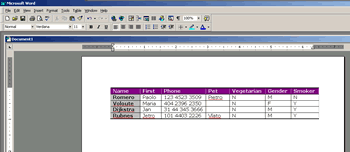
But, lets say a hotel, collects data from a lot of people: past, present and future guests. Stores preferences: smoking non smoking, what ever. Our hotel is famous for its animal correctness so what the heck let's collect the name of the guest's pet too! Now this is a lot of "data" and again here is the question: how do you find your way in all this mess.
Did the reception write all this on a piece of paper? Disaster!
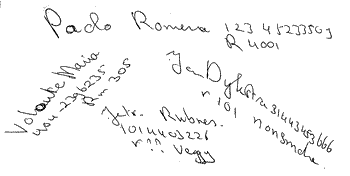
Maybe the reception desk is organized and put all names on stock cards? And in alphabetical order?
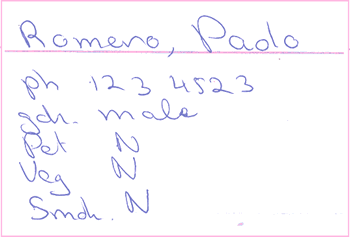
The hotel got very very busy, and the desk had no time to keep track of all this information. "We are a hotel not an airline!", is vaguely muttered by the "gerant" when he lost your name again and booked the same room twice.
And here comes the database
You might imagine that a hotel is nothing else than a database of rooms.
|
|
|||||
|
Roomlist
|
20 Dec
|
10:11
|
|||
| Name | First | Gender | Out | Room | Smoker |
| Dijkstra | Jan | M | Y | 101 | N |
| Romero | Paolo | M | Y | 104 | N |
| Rubnes | Jetro | M | Y | 201 | Y |
| Voloute | Maria | F | N | 299 | Y |
| Xantia | Citon | F | N | 300 | Y |
| Zeppelin | Ger | M | N | 301 | Y |
And a database is nothing else then a collection of data stored in an orderly way.
| Name | First | Phone | Gender | Pet | Vegetarian | Smoker |
| Dijkstra | Jan | 31 44 345 3666 | M | Y | N | |
| Romero | Paolo | 123 4523 3509 | M | Pietro | N | N |
| Rubnes | Jetro | 101 4403 2226 | M | Vlato | N | Y |
| Voloute | Maria | 404 2396 2350 | F | N | Y |
Orderly, so you can find back what you are looking for. A database can have any physical form: paper, on a blackboard, an electronic file, or even some tally sticks. (a very early form of a database in 1310)
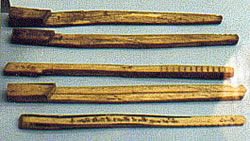
The difference between a database and a file is that there is something extra to it. A method to look up something, in other words some sort of system.
Case study: Hotel Bincker
Next time you show up at the hotel Binckers' desk the "gerant" fingers through his agenda which is ordered by date and he will find your reservation back. This method is prone to make a mistake if there is not some sort of room reservation combined with the agenda. These two methods combined will be the basis of our case study: a hotel database.
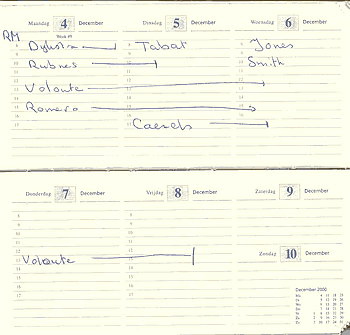
But Bincker's hotel is a arge hotel with over 100 rooms, and the need for a combined agenda and guests lists is almost compulsary.
Here is a selection from the room list showing the vacancies:
|
|
|||||
|
Vacancies
|
20 DEC
|
10:11
|
|||
| Name | First | Gender | Out | Room | Smoker |
| 102 | N | ||||
| 105 | N | ||||
| 202 | Y | ||||
| 205 | Y | ||||
| 302 | Y | ||||
| 303 | Y | ||||
Here is part of the guest llist
|
|
|||||
|
Roomlist
|
20 DEC
|
10:11
|
|||
| Name | First | Gender | Out | Room | Smoker |
| Dijkstra | Jan | M | Y | 101 | N |
| Romero | Paolo | M | Y | 104 | N |
| Rubnes | Jetro | M | Y | 201 | Y |
| Voloute | Maria | F | N | 299 | Y |
| Xantia | Citon | F | N | 300 | Y |
| Zeppelin | Ger | M | N | 301 | Y |
We are almost there.
Here is a part of the address list
| Name | First | Address | Notes | Phone | Gender | Pet | Vegetarian | Smoker |
| Dijkstra | Jan | 14 Pinkerton lane Deloit, 1234DE Delaware USA |
Yes | 31 44 345 3666 | M | Y | N | |
| Romero | Paolo | Plz de 5 Mayo 123 4325-23 Roma Italy |
No | 123 4523 3509 | M | Pietro | N | N |
| Rubnes | Jetro | 123 Pole 23 Deliver to mailoffice San Remaro Trinidad |
Ye | 101 4403 2226 | M | Vlato | N | Y |
| Voloute | Maria |
12 rue de la liberte |
No | 404 2396 2350 | F | N | Y |
When a desk clerk wants to have a quick view of available rooms:
| Room | Price | SU | MO | TU | WE | TH | FR | SA | SU | MO | TU | WE | TH | FR | SA |
| 20 | 21 | 22 | 23 | 24 | 25 | 26 | 27 | 28 | 29 | 30 | 31 | 01 | 02 | ||
| 101 | 120 | ||||||||||||||
| 102 | 120 | ||||||||||||||
| 103 | 120 | ||||||||||||||
| 104 | 120 | ||||||||||||||
| 105 | 120 | ||||||||||||||
| 201 | 100 | ||||||||||||||
| 202 | 100 | ||||||||||||||
| 206 | 100 | ||||||||||||||
| 207 | 100 |
This chart is color coded, blue is a guest, green is available, yellow is a national holyday or other special day (mostly meaning prices go up) When a client wants more specifics a clerk can open a subwindow to search for a room (in all possible combinations: adjecent rooms, smoke free,
The next chapter will introduce more methods and techniques used with databases: reporting, sorting, display, storing data, technologies and other introductory subjects.
![]()
| Last Updated on December 14, 2003 | For suggestions please mail the editors |
Footnotes & References